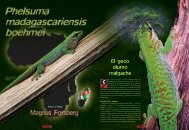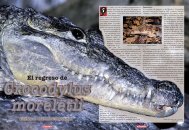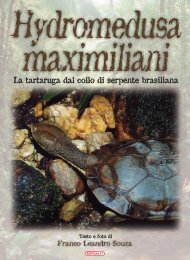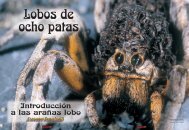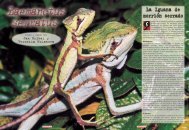The Casquehead Iguana - Laemanctus serratus - Reptilia
The Casquehead Iguana - Laemanctus serratus - Reptilia
The Casquehead Iguana - Laemanctus serratus - Reptilia
Create successful ePaper yourself
Turn your PDF publications into a flip-book with our unique Google optimized e-Paper software.
it (which we had happen with a different species). Also,crickets were hiding under it. In any case, the lizardswere not using the water basin at all.Our casquehead iguana terrariums are located in agreenhouse, so they have plenty of natural light. We donot use any special lamps for UV light. Heating is providedwith a 60-watt ceramic bulb, which is kept on 24hours a day — except on hot summer days, when it isswitched off. <strong>The</strong> temperature directly under the bulbstays at about 35°C (95°F). Temperatures in other partsof the terrarium vary from about 26°C (79°F) to 30°C(86°F). At night the temperature drops a little, but notbelow 23°C (73°F). During winter the greenhouse isheated to at least 24°C (75°F). It is important to notethat these animals love high temperatures. Even at35°C (95°F) they continue to bask in the highest levelsof the terrarium. However, if the temperature dropsbelow 22°C (72°F) they stop eating and become brownin color.At first, the four younger lizards were housed in asmaller (similarly furnished) terrarium, but when theyreached the same size as the older pair, all six animalswere put together in a larger terrarium of 120 x 80 x 80centimeters (LxWxH).FeedingAdult and older juvenile casquehead iguanas are fedthree times a week, as much as they will eat. Gravidfemales and younger specimens are fed smaller quantitiesdaily. We feed them a diet of mostly crickets(Acheta domestica, Gryllus assimilis), locusts (Locustamigratoria), and cockroaches (Periplaneta americana,Blaptica dubia). We also sometimes offer larvae of thescarab beetle Pachnoda marginata peregrina, andapproximately once a month we feed each lizard a 1- or2-day-old pinky.All prey insects are always dusted with a mixture ofdietary supplements (Vitamix, Roboran H, Roboranfor exotics, Plastin, and crushed eggshells and cuttlebone).Once a month, the lizards are given drops of liquidvitamin A, D 3 , and E supplements. And two orthree times a year we give them a vitamin B-complexsupplement.L. <strong>serratus</strong> adult maleFrequent spraying with water is very important. Inwinter, two or three times a day is enough, but on hotsummer days, when the temperaturein the greenhouse goesabove 35°C (95°F), it isnecessary to spraymore often.In anycase,the substrateshouldnot become toowet, and the air inthe terrarium shouldnot be stifling, so adequateventilation is alsoimportant.ReproductionA big advantage of keeping thisspecies is that a large group can behoused in one terrarium. Males are not injuredin competition for mating, and there is no apparentpsychological pressure on weaker specimens.<strong>The</strong> first attempts at copulation begin in April or May.In courtship, the male faces the female, puffs out histhroat, and moves his head from side to side. We haveJuvenile about 6 weeks oldonly seldom seen these lizards actually copulating, andin such cases we have chosen to leave them alone ratherthan disturb them. This is why we have no data aboutthe copulation procedure or its duration.Gravidity is soon evident — the female gains weightquickly, and crossbands appear on her flanks.About 5 days before laying, the eggscan be felt through the sides of thefemale by palpation. At thistime the female stops eatingand starts climbing downto the ground to lookfor a suitable nestsite. <strong>The</strong> substrateshouldbe more than 5centimeters deepwhen females arelaying eggs. Substratemoisture is also important.If the ground is toowet, the eggs can absorbtoo much water and quicklymold; if it is not moistenough, the eggs can quicklydry out. If the femaledoes not find suitableconditions for laying,she may retain hereggs for severaldays and finallyleave themscatteredaroundtheL. <strong>serratus</strong>adultL. <strong>serratus</strong> eating a cricketHatchling just a few days oldterrarium. <strong>The</strong>se eggs are usually unable to survive. Inthe worst case, the female can retain the eggs so longthat she dies.During the last week before egg-laying it is best totransfer all the males to a different terrarium to keepthem from disturbing females that are trying to find nestsites and lay eggs. Also, we hand-feed the lizards withtweezers during the time before egg-laying. It is importantto make sure there are no free-roaming crickets orother prey insects in the terrarium when eggs are laid.A few hungry crickets can destroy a whole clutch ofeggs within minutes.In most cases we have observed laying in theafternoon. Eggs are laid in substrate of 5–6 centimetersin depth, and the female always coversthe nest perfectly, making it impossibleto distinguish from the surroundingground. Our clutches have consisted of5–9 eggs measuring an average of 12x 25 millimeters. Each female usuallylays two clutches per season— the first in late June orearly July; the second,35–40 days later. One ofour females laid threeclutches one year— of nine, seven,and six eggsrespectively.REPTILIA 50
L. <strong>serratus</strong> female laying eggs. <strong>The</strong> eggs are still softand glossyAfter laying, the female buries the eggs and concealsthe nestGravid femaleOne clutch incubating in vermiculiteL. <strong>serratus</strong> hatchling a few days old<strong>The</strong> third clutch was evidently oflower quality, but still produced fivehatchlings. This reproductive effortwas taxing for the female, but shesoon recovered.We incubate eggs in slightly dampvermiculite at a constant temperatureof 29.5°C (85°F), for an incubationperiod of 52–56 days. Initiallywe had a problem withwell-developed youngdying in their shells,but we found thatincreasing the substratemoisture 2–3days before expectedhatching helpsto prevent this fromhappening. Apparentlythe drier and hardereggshells were difficultfor the baby lizards tobreak through. Hatchlingsmeasure 13 centimeters in totallength, of which 9.5 centimeters istail. Size variation among babies isminimal.Care of hatchlingsWe house hatchlings (of the samesize) together in terrariums of 40 x30 x 40 centimeters (LxWxH). Forfresh hatchlings we line the floorwith filter-paper instead of othersubstrate — until the umbilicus iswell healed, it should be kept free ofsubstrate particles and other impurities.<strong>The</strong> terrarium is furnished withL. <strong>serratus</strong> juvenilesa few thin branches and live plantsin pots.Heating is provided by a 25-wattbulb. <strong>The</strong> temperature under thebulb stays at over 30°C (86°F); inother parts of the terrarium, atabout 25°C (77°). At lower temperatureshatchlings refuse to startfeeding and can die very quickly.We feed hatchlings daily, givingthem crickets that are smaller thanthose fed to adults, but dusted withthe same mixture of dietary supplements.We give hatchlings liquidvitamin A, D 3 , and E supplementsfor the first time atthe age of 2 weeks.Juveniles grow veryquickly. <strong>The</strong> sexescan be distinguishedafter 6–8 months,and sexual maturityis reached in 2years.Conclusion<strong>The</strong> beautiful serratedcasquehead iguana isnot the easiest species tomaintain in captivity. It needs areally warm and moist environment,regular spraying, and dietary supplementswith every feeding. Also,problems with eggs during incubationare not uncommon. But if youare able to meet these challengesyou can have the pleasure of successfullykeeping this unusual andinteresting lizard.■REPTILIA 52



